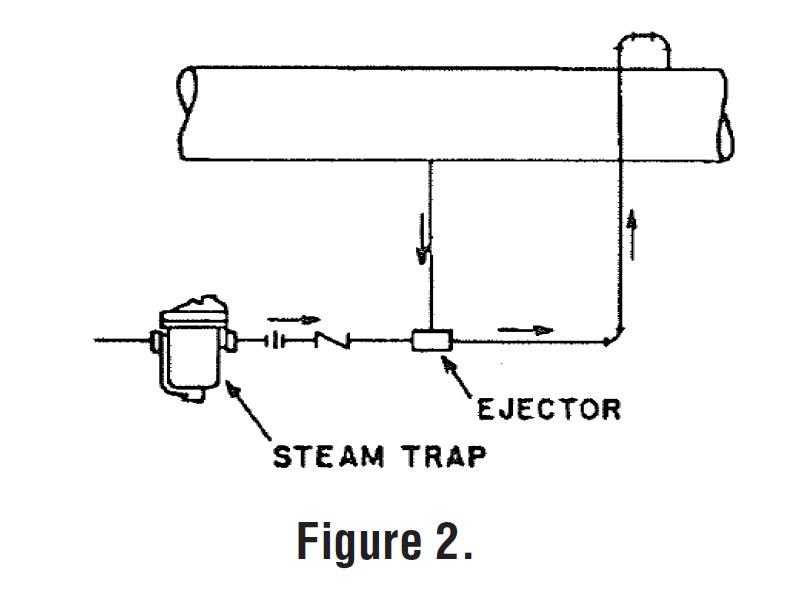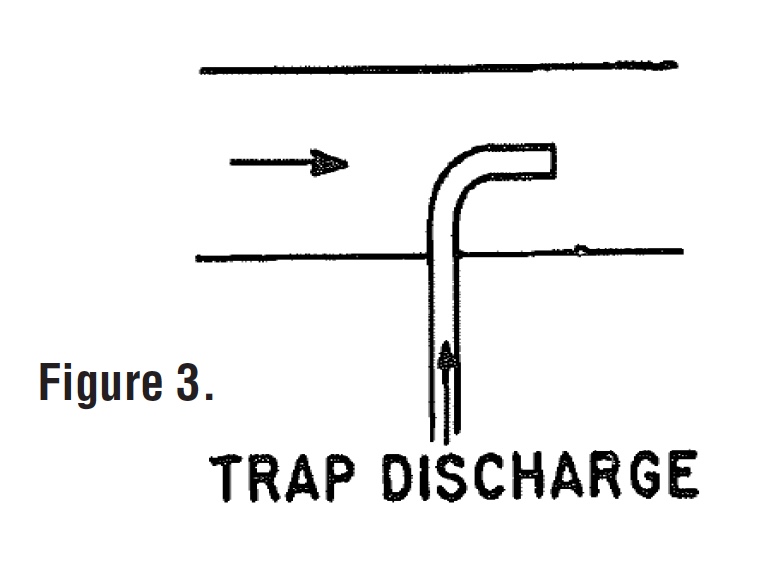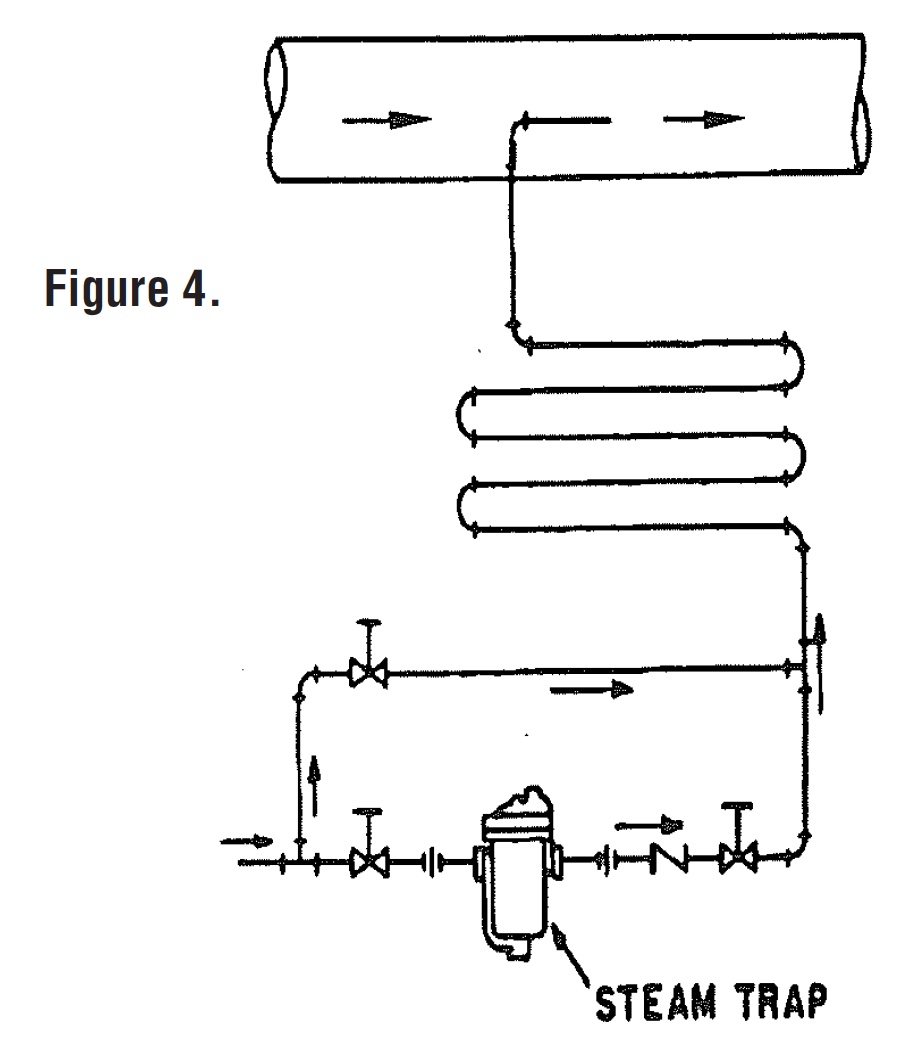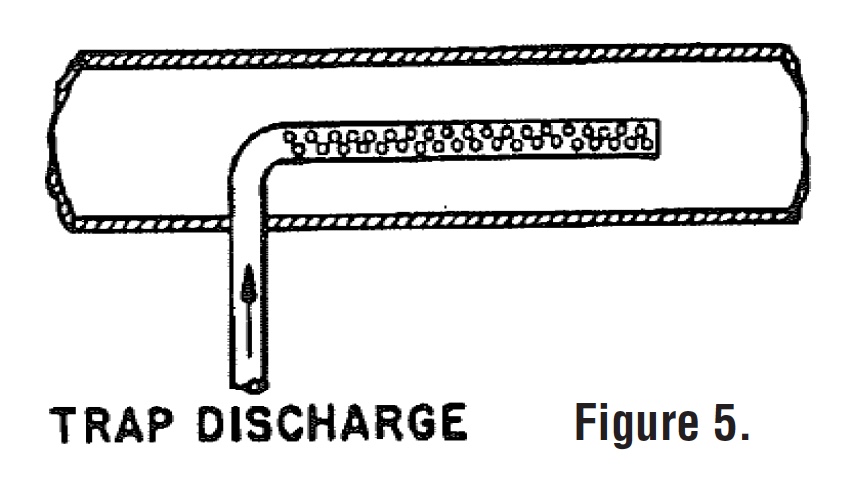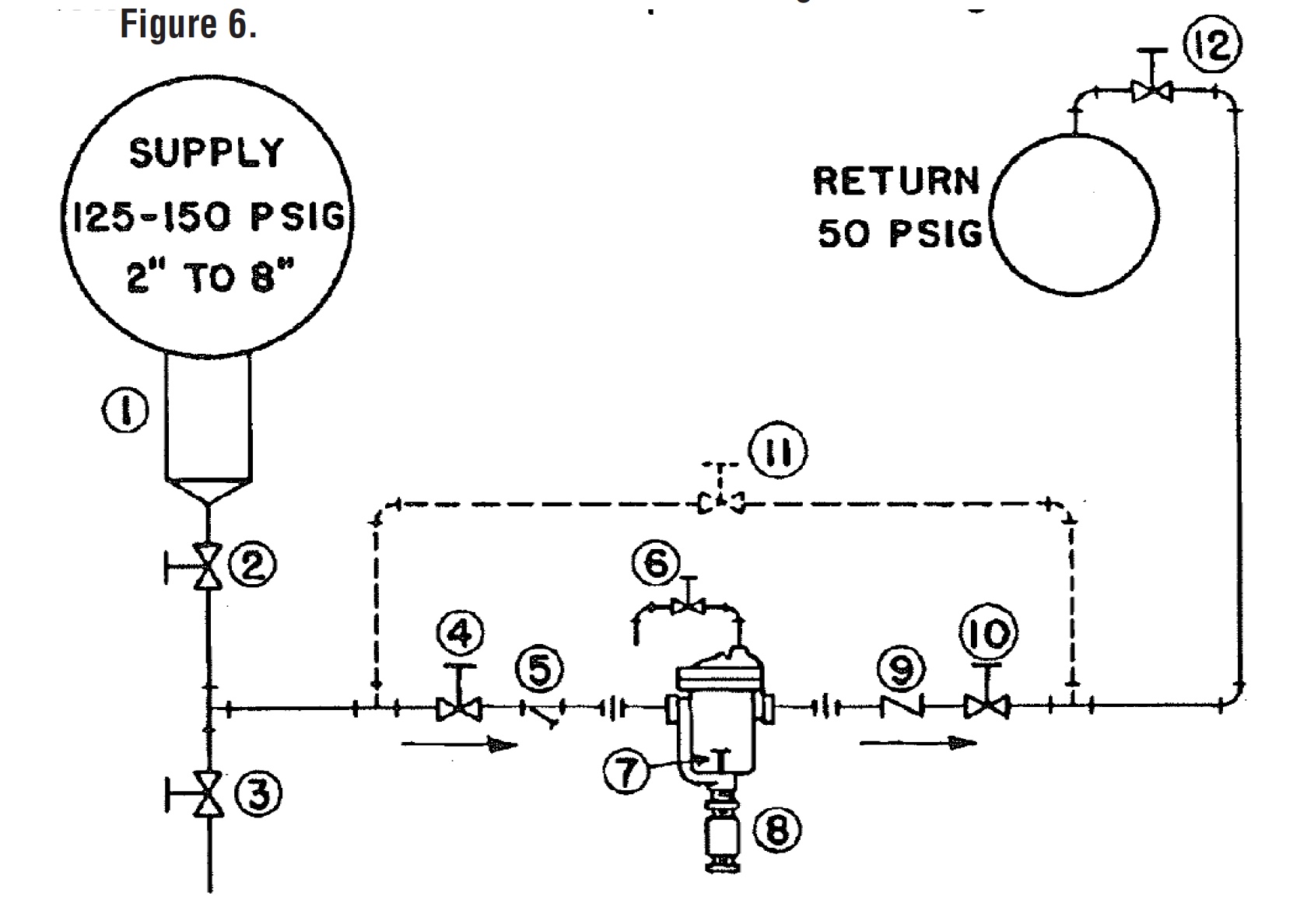Condensed from Armstrong TRAP Magazine
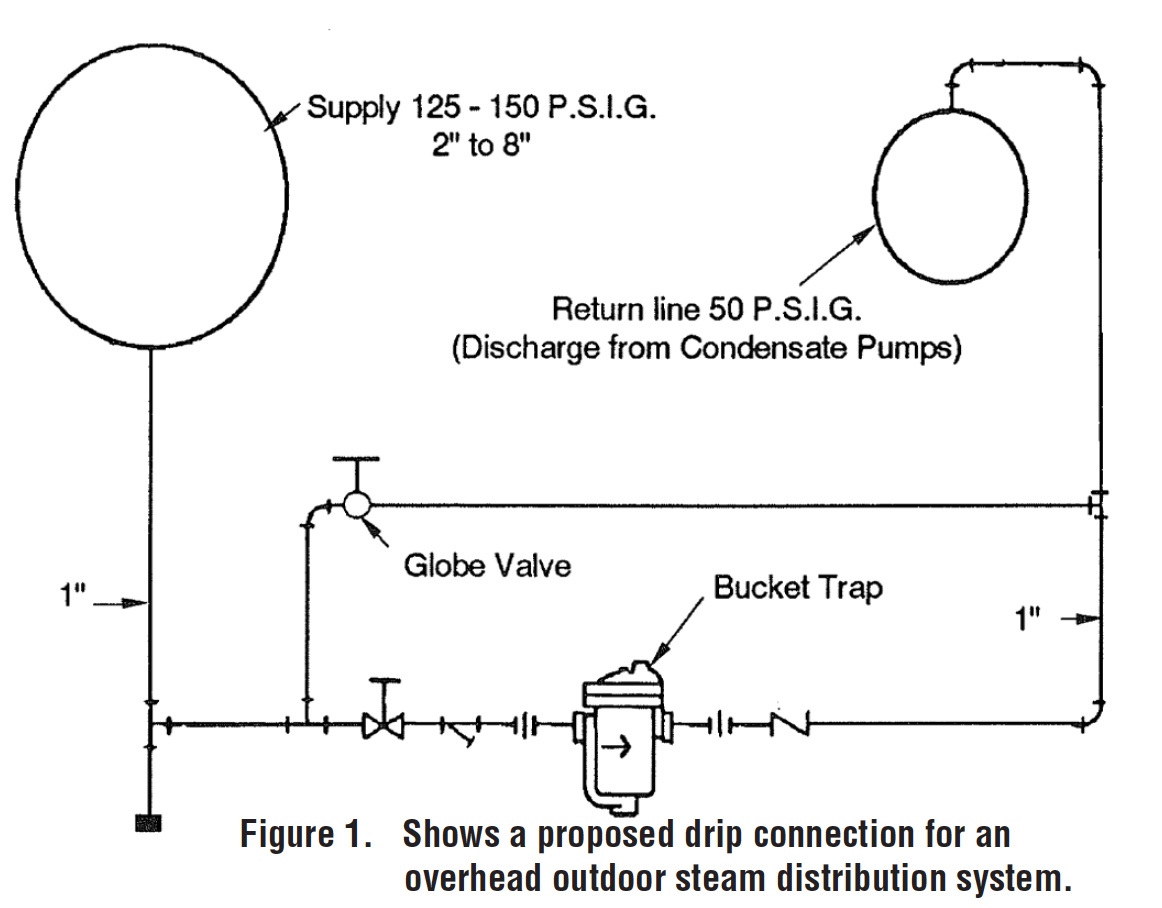
PROBLEM:
With the steam line pressure running from 125 lbs. to 150 lbs. there will always be sufficient differential for the traps to discharge to the return line. But this is not an ordinary condensate return line — with the condensate temperature fairly close to the steam pressure in the return line. The return line is handling the discharge from condensate pumps which are assumed to be taking condensate from low pressure traps and boosting the pressure so that it will flow back to the boiler room. The return line, is therefore, probably running full of condensate at the temperature of anywhere from 180˚F to 210˚F. Very likely it will be a lot lower than the temperature of the flash and condensate from the drip trap. Under these conditions water hammer could be quite a problem.
What do you think? If you agree that water hammer is likely, what do you suggest as an alterative hookup to the one shown in the accompanying sketch? Please give full reasons for your conclusions. The engineer that offers the best practical solution will receive an award post haste to compensate for their effort.
ANSWERS:
Ninety-three percent of those replying said there would be water hammer. In fact, several engineers proved with calculations that flash steam would form in sufficient quantities when the high temperature trap discharge met the lower pressure to make water hammer almost inevitable. The TRAP Magazine judges agreed that under the conditions stated in the problem, water hammer would very probably occur, even though some readers reported that under somewhat similar conditions they had no problem.
Suggested solutions fell into the following categories:
1. Discharge the trap to atmosphere. This was eliminated as being unnecessarily wasteful.
2. Discharge the trap to a receiver.
3. Discharge the trap to a heat exchanger.
4. Discharge the trap to a flash tank.
Solutions 2, 3, and 4, while perfectly valid means of avoiding water hammer, generally would be more expensive and complicated than the situation calls for.
Again, it’s recognized that there are circumstances where any one of these solutions could be considered ideal, but the solution named as best must apply generally.
5. External radiation. These included long drip legs ahead of the trap, long return lines from the trap, fin type radiation, tempering coils, etc. Such systems did not get the nod because of the needless expense, as well as the waste of heat.
6. Ejectors. Solutions employing ejector ran a very close second to the winner.
Reader T. Mackie, Head Plumber, Royal Alexandra Hotel, Winnipeg, Manitoba, exemplifies this school: “It is my belief there will be water hammer and to overcome this difficulty it would be my suggestion to install an ‘ejector’ such as Penberthy XL96” of the proper size and installed as illustrated in the accompanying sketch (Figure 2).
“The high pressure discharge from the trap while passing through the ejector will pick up water from low pressure return and so will reduce the temperature of the high pressure discharge to nearer the low pressure temperature and in this way avoid water hammer.”
The advantages of such a system are obvious. It is simple and inexpensive. It works. It wastes no heat.
7. Special means of admitting the high pressure discharge into the 50 psi return header.
THE WINNER:
This category contained the winner. W.F. Gundlack, C.E., Twin Cities Arsenal, Federal Cartridge Corporation, New Brighton, MN, came up with a hookup remarkable in its simplicity. Figure 3 demonstrates this. In the opinion of the TRAP Magazine judges, admitting the flash steam in the direction of the flow of the condensate in the manner shown will be sufficient to prevent water hammer. Mr. Gudlack also offered the installation of tempering coils (Figure 4) in conjunction with the curved nipple as an even surer cure for water hammer, but this should not be necessary in most cases. The award therefore goes to W.F. Gundlack on the basis of providing the simplest, most practical and proven solution.
NEAR MISSES:
J.M. Parish, Mechanical Engineer, Dow Chemical Company, Freeport, TX was close to the winning solution when he stated “…inject the trap discharge into the condensate line though a properly designed nozzle,” but did not include enough detail.
A similar solution employing the same method of admitting the flash steam but using perforated piping (Figure 5) was advanced by readers, P.F. Krol, Cranford, NJ and J.M. Perish, Freeport, TX. In this system, flash steam is admitted more gradually and over a greater area, though still at right angles to the condensate flow, which may cause some turbulence.
TIPS ON IMPROVING PIPING PRACTICES
With the water hammer problem out of the way, several engineers went on to improve the general piping from that which was originally shown, particularly in consideration of the fact that this is an outdoor installation and freezing is a definite consideration.
The TRAP Magazine presented an unmodified customer’s drawing and was criticized about some omissions. Figure 6 therefore rights this situation by revising the original to conform with the “American Standard Code for Pressure Piping”.
1. Drip pocket.
2. Shut off valve as close as possible to steam main and at high point on outdoor installation.
3. For free blow to atmosphere also getting sediment out of dirt pockets.
4. Permit shut off for trap inspection or removal; necessary if bypass is used, otherwise convenient.
5. Strainer — not necessary on larger Armstrong inverted bucket traps.
6. Test valve — optional.
7. When valve (3) is opened for manual blowdown, there will be a pressure drop in the line to the trap which may cause trap prime to flash and make the trap lose its seal. Such traps should be protected by installing an Armstrong Internal Check Valve, (7) or by a swing check valve between the trap and valve.
8. Pop Drain protects trap against freezing, automatically drains trap when the steam pressure is below 8-9 psi. Check valve (7) should not be used with pop drain, although strainer (5) with blow down valve is essential. Check valve (9) may also be omitted.
9. This check valve prevents backflow into the trap.
10. Permit shutoff for trap inspection or removal; necessary if bypass is used, otherwise convenient.
11. Bypass valve
12. Shutoff valve as close as possible to return header and at high point on outdoor installation.
One reader questioned the use of a bypass on an outdoor installation. Many would subscribe to omitting the bypass particularly when using Armstrong traps which seldom need attention. If a bypass is used, provision for draining it to prevent freezing is recommended.

